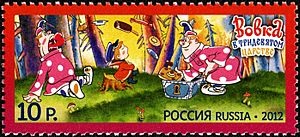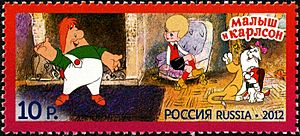Boris Stepantsev facts for kids
Quick facts for kids
Boris Stepantsev
|
|
|---|---|
| Born |
Boris Pavlovich Stepantsov
7 December 1929 |
| Died | 21 May 1983 (aged 53) |
| Occupation | Animator, artist, book illustrator |
Boris Pavlovich Stepantsev (Russian: Борис Павлович Степанцев; December 7, 1929 – May 21, 1983) was a very talented Soviet and Russian animation director. He was also an animator, artist, and illustrated many books. Boris Stepantsev was a vice-president of ASIFA, an international group for animated films. He also led the animation department at Studio Ekran from 1980 to 1983. In 1972, he was honored as a Merited Artist of the RSFSR for his amazing work.
Contents
The Life of Boris Stepantsev
Early Life and Animation Dreams
When Boris Stepantsev was a child, he fell in love with cartoons. He thought they were "the funniest thing in the whole world." This made him decide to spend his life making funny animated movies. He went to the Moscow Art School. In 1946, after World War II, he joined animation classes at Soyuzmultfilm. There, he watched many "trophy" movies, including films by Disney. These Disney films greatly inspired him.
First Steps in Animation
From 1947 to 1949, Stepantsev worked as an animator on several films. One of these was the award-winning Grey Neck (1948). After serving in the Soviet Navy for five years, he went to the Moscow State University of Printing Arts. He also kept working in animation.
In 1954, he co-directed his first short film, A Villain with a Label. This was one of the first stop motion (puppet animation) films made at Soyuzmultfilm's new puppet division.
Creating Popular Cartoons
Starting in 1955, Boris Stepantsev often worked with Anatoly Savchenko. Savchenko was an art director and his regular partner. They worked together on many animated films and art projects. These projects also included book illustrations and filmstrips for the Diafilm studio.
In 1958, they made Petya and the Little Red Riding Hood. This was a funny, modern cartoon based on a fairy tale. It was about a young pioneer boy named Petya. He sneaked into the Little Red Riding Hood movie to save the girl from the Big Bad Wolf. This film was inspired by Disney and Tex Avery cartoons. It was different from most "realistic" movies of that time, which used a technique called rotoscopy (tracing over live-action footage). The film became very popular and won a prize in 1960. In 1962, they made a follow-up called Not Just Now. In this film, a real child actor played Petya. He traveled through time and interacted with hand-drawn cartoon scenes.
From 1956 to 1960, Stepantsev also directed one of the first Soviet mini-series. It starred Murzilka, a popular character from a children's magazine. The third part, Murzilka on Sputnik (1960), was the first Soviet widescreen animated short film. It won first prize at a film festival in 1960. After 1963, Stepantsev began directing films on his own.
Vovka and Karlsson
Between 1965 and 1970, he created three of his most famous movies. One was Vovka in a Far Far Away Kingdom (1965). This was another funny cartoon about a lazy boy named Vovka. He found his way into a book of Russian fairy tales.
He also made two films about Karlsson-on-the-Roof (1968, 1970). These were based on the fairy tale by the Swedish author Astrid Lindgren. These Karlsson films were the first Soviet animated movies to use xerography (a copying process). These cartoons had colorful art, funny conversations, and great voice actors. They became very quotable, and the main characters became beloved cartoon icons. Stepantsev and Savchenko even illustrated Cheburashka's adventures for Diafilm strips in 1968.
Music and New Styles
Around this time, Stepantsev felt he was "tired of quizzery" (making only funny films). He decided to explore other themes. He directed two films without any spoken words. These films were based only on classical music. They were Window (1968), inspired by Sergei Prokofiev's music, and The Nutcracker (1973). The Nutcracker was based on Tchaikovsky's famous ballet. Stepantsev said that Prokofiev's music "drew what should happen on screen by itself." When making The Nutcracker, he and the cameraman used special trick photography. Both movies won awards at international film festivals.
In 1967, they made Song of a Falcon. This was the first Soviet widescreen paint-on-glass animation film. It was based on a story by Maxim Gorky. This film also used classical music by Alexander Scriabin to tell the story. In 1972, Stepantsev became a vice-president of ASIFA, serving until 1982.
Later Work and New Ideas
In 1974, Stepantsev moved to the puppet division of Soyuzmultfilm. There, he directed two stop motion (puppet animation) short films. These were based on parts of Nikolai Gogol's novel Dead Souls. After this, Stepantsev left the studio. He became the creative director of the Multtelefilm animation department at Studio Ekran from 1980 until his death.
Stepantsev liked to spend a lot of time developing his films. But he also easily switched to new projects when a new idea excited him. Because of this, neither the Karlsson-on-the-Roof nor the Dead Souls series were ever fully finished. In one of his last writings, he was very excited about computer animation. He believed it would be the future of animation.
His last project was Assol (1982). This was his first full-length film. It was based on the Scarlet Sails novel. For this film, he combined live action with traditional animation. He wanted to make a live actor look like a cartoon character using new photography techniques. The film had a very unique look, "as if it went through the Prisma app." Working on this movie was very difficult and stressful. It sadly affected the director's health.
Boris Stepantsev passed away in 1983 at the age of 53 from heart failure.
A Look at His Films
As a Director
- 1954 — A Villain with a Label
- 1956 — Murzilka Adventures. Issue 1
- 1957 — Grade D, Again
- 1958 — Petya and the Little Red Riding Hood
- 1960 — Murzilka on Sputnik
- 1962 — Not Just Now
- 1964 — A Cock and Paints
- 1965 — Vovka in a Far Far Away Kingdom
- 1966 — Window
- 1967 — Song of a Falcon (also screenwriter)
- 1968 — Junior and Karlson
- 1970 — Karlson Returns
- 1971 — Heart (also screenwriter)
- 1971 — Pioneer's Violin
- 1973 — The Nutcracker (also screenwriter)
- 1974 — Chichikov's Adventures. Manilov (also screenwriter)
- 1974 — Chichikov's Adventures. Nozdryov (also screenwriter)
- 1976 — Fly-Clatterfly (also screenwriter)
- 1979 — Why Did the Donkey Become Stubborn (also screenwriter)
- 1982 — Assol (also screenwriter)
As an Animator
- 1947 — Merry Garden
- 1947 — Adventure to the Land of Giants
- 1948 — Grey Neck
- 1948 — Champion
- 1949 — Geese-Swans
- 1949 — A Lion and a Hare
- 1949 — Mashenka's Concert
- 1949 — Polkan and Shavka
- 1954 — Goat-Musician
- 1954 — At the Forest Stage (also art director)
- 1954 — The Signature Is Unclear
- 1955 — Incredible Match



